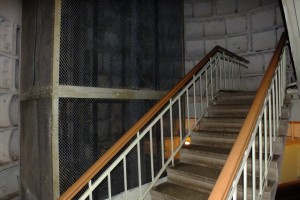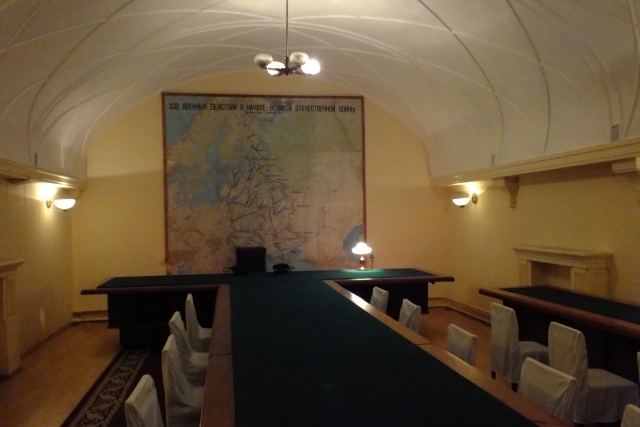Once a top-secret Soviet facility, Stalin’s secret bunker is now open to the public. Peter Campbell from Intrepid Adventure writes the first full account of the bunker to be published in English on the internet.
Thirty-five metres underground the air feels denser, cold and clammy. Welcome to Josef Stalin’s secret bunker.
The bunker, located in the centre of Samara (known as Kuibyshev from 1935 to 1991) was dug during the desperate days of World War II. German troops were only 16 kilometres from Moscow. Leningrad was besieged. On 15 October 1941, fearing the Germans would take the Soviet capital the State Committee for Defence took a decision to evacuate key industries to Kuibyshev and prepare the city to act as a centre of operations in the event of the Germans reaching Moscow. Kuibyshev became the “Reserve Capital” of the Soviet Union.
Work secretly began on Stalin’s bunker. Workers dug a tunnel from a militarised zone on the Volga River embankment 400-500 metres in length to the site of the bunker and cut out the shell of the bunker using technology similar to what is used for building the Russian metro systems. The dug out bunker was then protected with reinforced concrete plates. The work was completed in nine months with local residents completely unaware of the work occurring beneath their feet.
The bunker was designed to protect Comrade Stalin and his inner circle from bombardment and gas attacks.
The bunker comprises five stories and is 35 metres deep – the equivalent of the height of a 10 storey building. The top storey had technical equipment, including a power generator and the air conditioning and the filtration system for reusing air – the first in the Soviet Union.The bunker was designed to function autonomously for five days and maintained a temperature of 16 degrees Celsius for the corridors and 18 degrees inside rooms.
The lowest floor houses Stalin’s lounge and meeting room – both are miniature copies of the rooms he had in Moscow and reveal a man of spartan tastes. His lounge comprised a small desk with a green, felt top, a matching desk-light, a stylish retro 1940s’ telephone and a white couch with silk covering.
Two simple, water colour paintings hang on the wall – portraits of generals Stalin admired: Field Marshal Suvorov and General Kutuzov. Suvorov was a late 18th century general who fought in the Seven Years War, the Russo-Turkish Wars, the Warsaw Uprising and also against Napoleon in Italy. He commanded 93 battles without loss. Kutuzov fought in the Warsaw Uprising and Russo-Turkish Wars. He led the withdrawal at the Battle of Borodino, near Moscow, and subsequent counter-attack that drove Napoleon from Russia.
Although the room has only two exits, several false doors create the illusion of space. It is also said that the additional doors were designed to unsettle visitors who would be left wondering who or what was concealed behind them. Given Stalin’s paranoia, it is hardly surprising that he was also mildly claustrophobic – the illusion of space, which the false doors gave him, was therefore supposedly beneficial.
The ceiling was vaulted, and painted in pale shades of blue, pink and white, while the light fittings are what you would see in any home of the period.
The wooden parquet of the bunker’s lowest floor was covered by a red, woollen carpet that ran down the centre of the corridors and covered the floor in his lounge and meeting room. Stalin apparently had a taste for the good things, a silk covered couch for example, but if his personal bunker is anything to go by, he was a man of simple tastes and basic needs.

Escaping into air-raid shelters was a good way to stay healthy – giving people strong motivation to stay active
However, the bunker was never used. Stalin decided to remain in Moscow and the evacuation of foreign embassies had the advantage of clearing Moscow of foreign dignitaries and potential spies. Kuibeshev maintained its status as the Reserve Capital until summer 1943 when government offices and cultural institutions were relocated back to Moscow. The industrial factories were left behind, making Kuibyshev an important industrial centre and the focus for the aerospace industry. For this reason Kuibyshev was closed to foreigners until 1991 and Stalin’s bunker remained a closely guarded secret.
Many of the workers involved in building Stalin’s bunker survived. Bunkers and secret emergency tunnels were needed throughout the Soviet Union and after the war, work began on building the Moscow metro system, consequently, the engineers involved mostly lived out their natural lives and after declassification have even visited the facility.

This unprepossessing building attached to the rear of the Samara Academy of Culture and Arts is the entrance to Stalin’s bunker
Stalin’s Bunker
Address: Frunze 167, Samara
Opening hours: Monday-Friday, 11.00-15.00
Cost: 80 roubles.
Phone: +7 (846) 333-35-71
The entrance is located in a courtyard behind the Academy of Culture and Arts opposite the Drama Theatre not far from Kuibyshev Square. Although it is possible to visit Stalin’s Bunker independently on Wednesdays at 1pm, it is best to go through an organised tour with a tour agency (which will cost extra).
Be sure to like Intrepid Adventure on Facebook and check out Peter Campbell’s latest books on Amazon.com.
Copyright © Peter Campbell 2014, www.intrepid-adventure.com





